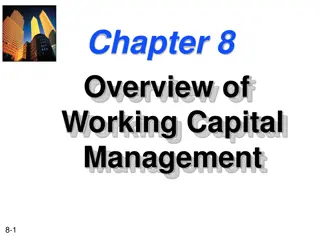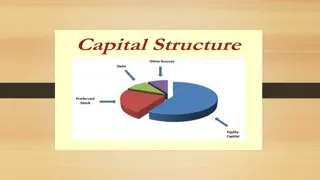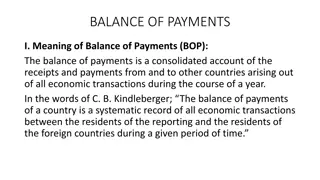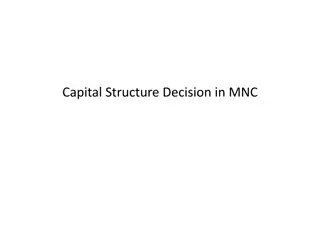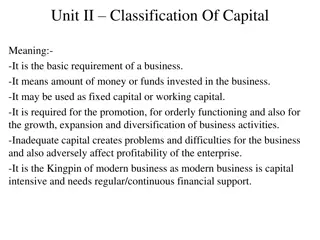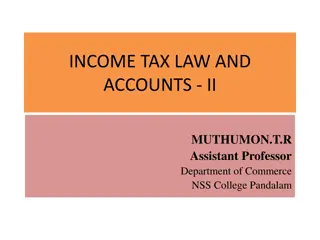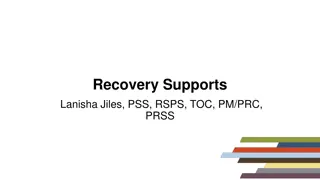
Working Capital Assessment and Cash Flow in Business Operations
Explore the significance of working capital in managing short-term obligations and ensuring smooth business operations. Learn about assessing working capital, sources, methods, and implications for businesses. Gain insights into the gross and net working capital, and understand how it impacts financial stability.
Download Presentation

Please find below an Image/Link to download the presentation.
The content on the website is provided AS IS for your information and personal use only. It may not be sold, licensed, or shared on other websites without obtaining consent from the author. If you encounter any issues during the download, it is possible that the publisher has removed the file from their server.
You are allowed to download the files provided on this website for personal or commercial use, subject to the condition that they are used lawfully. All files are the property of their respective owners.
The content on the website is provided AS IS for your information and personal use only. It may not be sold, licensed, or shared on other websites without obtaining consent from the author.
E N D
Presentation Transcript
HINDUSTHAN COLLEGE OF ARTS AND SCIENCE DEPARTMENT OF COSTUME DESIGN AND FASHION SEMINAR TOPIC (WORKING CAPITAL ASSESMENT AND CASH FLOW FINAL ACCOUNT) SUBMITTED BY : S.SETHUPRIYA, M.sc.,(costume design and fashion)
WORKING CAPITAL ASSESMENT what is working capital : Funds required to fulfill short term obligations & smoothly conduct routine business operation. The goal of working capital management is to ensure that the firm is able to continue its operations and that it has sufficient cash flow to satisfy both maturing short-term debt and upcoming operational expenses. GROSS WORKING CAPITAL = CA ( These are in the system used/ consumed on a day to day basis) NET WORKING CAPITAL= CA-CL (The entrepreneur s margin available in the system from long term funds)
Working capital is important we work out the right level of working capital. If the working capital is too: HIGH- business has surplus funds which are not earning a return LOW- may indicate that business is facing financial difficulties
SOURCE OF WORKING CAPITAL FUND BASED cash credit/over draft packing credit demand loan bill finance NON FUND BASED letter of credit bank guarantee
ASSESMENT METHODS Operating cycle method Drawing power sector Turnover method MBPF method cash budget method
OPERATING CYCLE METHOD EXAMPLE Operating cycle the average number of days it takes to turn raw material into cash proceeds from sales operating cycle =days of inventory + days of receivables . raw material procurement work in progress finished goods receivable cash
DRAWING POWER METHOD EXAMPLE PARTICULARS STOCK VALUE MARGIN DP & formula Paid stocks (a) (e) [a*(1-e)] Semi finished goods (b) (f) [b*(1-f)] Finished goods (c) (g) [c*(1-g)] Book debts (d) (h) [d*(1-h)] Total:
TURNOVER METHOD A. sales turnover B. 25% of sales turnover C. 5% of sales turnover projected as margin D. Actual NWC existing as per last financial statement E. (B-C) F. (B-D) G. additional margin to be brought in (C-D)
MPBF method Excess borrowing (short fall in NWC) shall be ensured by additional funds to be brought in by the applicant or by additional bank finance over MPBF. Important asspects of (mpbf )method : production/sales estimates Profitability estimates Inventory/receivables norms Build up of net working capital
CASH BUDGET: fore casted cash flow statement showing estimates of cash receipts, cash payments and net cash balance over the project term Peak deficit is financed Banks & financial institutions supervise the end use of the funds sanctioned through actual cash flow
PURPOSE OF CASH FLOW STATEMENT Predict future cash flow Evaluate management decisions Determine the ability to pay dividends to stockholder and payment to creditors Show the relationship of net income to the business cash flow
The cash flow statement provides information about: Cash receipts(cash inflows) Uses of cash (cash out flows) During a period of time Inflows and outflows of time: operating activities Investing activities Financing activities
CASH INFLOWS OPERATING ACTIVITIES INVESTINGACTIVITIES FINANCING ACTIVITIES ___________________________________________________ BUSINESS _____________________________________________________ 1.cash paid for expenses 2.purchases of investment loans to others 3.repurchase of stock,debt CASH OUTFLOWS
Preparing a statement of cash flows use net operating income as the starting point to get net operating cash flow net cash flow = cash inflow cash outflow Direct method and indirect method companies favor the indirect method for two reasons: 1. It is easier and less costly to prepare 2. It focuses on the differences between net income and net cash flow from operating activities
SIMPLE EXAMPLE FORV WHAT IS CASH FLOW COMPANY A EARNINGS FOR THIS YEAR Cash this year Cash next year revenue 100 crore 80 crore 20 crore Cost expenses -60 crore -50 crore -10 crore profit 40 crore In this table we cannot calculate the profit because cash flow for this year only 80 crore balance postponed to next year and cost expenses -50 crore this year balance post postponed to next year so we cant calculate this cash flow easily. Now we are going to see basic cash flow balance sheet for this table.
sales Cash inflow (this year) Cash outflow ( this year) 100 crore 80 crore + add previous year sales + add future year sales This year buisness have 60 crore cost &expenses (see the previous table) We only pay 50 crore for this year so have to recorded only 50 crore in cash + add previous year cost & expenses + add future year cost & expenses












